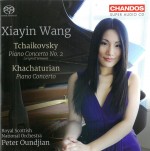 Xiayin Wang has recorded nearly a dozen CDs. Tchaikovsky – Piano Concerto No.2; Khachaturian – Piano Concerto; Royal Scottish National Orchestra; Peter Oundjian (Chandos CHSA 5167) is her fifth for this label.
Xiayin Wang has recorded nearly a dozen CDs. Tchaikovsky – Piano Concerto No.2; Khachaturian – Piano Concerto; Royal Scottish National Orchestra; Peter Oundjian (Chandos CHSA 5167) is her fifth for this label.The Tchaikovsky Piano Concerto No.2 is a big play at almost 45 minutes. This recording is of the original version, not the shorter one with significant cuts by Taneyev to the second movement. Wang proves to be a very precise player with a lot of stamina for whom Tchaikovsky’s wilder passages pose no difficulty. She is also comfortable with long interpretive pauses that give better definition to the deluge of musical ideas the composer releases in the opening movement.
Very much in command of her music when pitted against the orchestra, she also plays beautifully when more exposed with only solo violin and cello, as she is in the second movement. Similarly, in the Khachaturian Piano Concerto, Wang sustains long passages of simple octaves with great discipline, always sensitive to the mystery of the work’s Asiatic atmosphere.
Toronto-born conductor Peter Oundjian leads the Royal Scottish National Orchestra of which he has been music director since 2012. The RSNO is superb and deservedly claims its reputation as one of Europe’s leading orchestras. Both concertos require a broad range of stylistic and dynamic expression which the orchestra handles beautifully. They do especially well with the often angular nature of the Khachaturian. This recording brings together a wonderful team of musicians in a pair of truly demanding works. The result is a highly energized and superb performance.
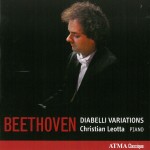 With all 32 Beethoven sonatas in his discography, Christian Leotta has now added Beethoven – Diabelli Variations (ATMA ACD2 2485) to his growing list of recordings.
With all 32 Beethoven sonatas in his discography, Christian Leotta has now added Beethoven – Diabelli Variations (ATMA ACD2 2485) to his growing list of recordings.
The Diabelli Variations have a history of divided critical opinion. At worst, Anton Diabelli’s original theme is considered a trite offering containing very little that any composer can use for a credible variation. That Beethoven used the material to write an entire set of 33 variations, is then something of a miracle that speaks directly to the composer’s inventive gift. Regardless of the theme’s actual merits, or lack of them, a performer needs to understand what Beethoven is actually doing in each variation in order to perform them intelligently.
This is where Leotta proves his standing as a highly respected Beethoven interpreter. He understands that Beethoven uses as little as a single interval and often barely more than that, a pick-up note, an ornament or a rhythmic pattern, to construct his variations. He remains highly focused on this, and in doing so holds the set of variations together despite its diverse moments of comedy, tumult, melancholy and contemplation.
Leotta has discerned Beethoven’s deepest imprint and conveys it in each of these utterances. What he makes clear by the end of it all is that Beethoven’s creative genius is for him, supreme.
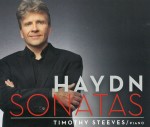 Timothy Steeves, known for his six recordings with violinist Nancy Dahl as Duo Concertante, has now released his first solo disc, Haydn Sonatas (Marquis MAR 469). Steeves admits to having a lifelong admiration for Haydn’s music and his choice of the three sonatas on this disc is meant to show Haydn’s creativity and originality. While the modern ear may have difficulty in hearing this music as original, because of its similarities to baroque and Mozartian works, a quick self-reminder as to where Haydn sits historically helps place him as the significant bridge from the baroque to the classical period.
Timothy Steeves, known for his six recordings with violinist Nancy Dahl as Duo Concertante, has now released his first solo disc, Haydn Sonatas (Marquis MAR 469). Steeves admits to having a lifelong admiration for Haydn’s music and his choice of the three sonatas on this disc is meant to show Haydn’s creativity and originality. While the modern ear may have difficulty in hearing this music as original, because of its similarities to baroque and Mozartian works, a quick self-reminder as to where Haydn sits historically helps place him as the significant bridge from the baroque to the classical period.
Steeves plays with great clarity, required especially in the upper voices where Haydn tends to nest his melodies. He has a touch that demonstrates impressive control of tonal colouring, so important in the slow movements of the sonatas. The Adagio of the Sonata in A-Flat Major Hob.XVI:46 is an example of how Steeves gives the middle register a lovely dark sound while it supports a brighter upper voice. And while Haydn rarely creates the complex counterpoint we associate with Bach, Steeves pulls out inner voices whenever Haydn sends them lower down the keyboard.
The Sonata in C Minor Hob.XVI:20 opening movement is a telling example of how ornamentation remained a staple of keyboard writing style from the Renaissance, through the baroque and into the classical period. Steeves is meticulous throughout the first movement where Haydn has inserted trills and grace notes liberally. The Andante is noteworthy for the freedom Steeves takes with its phrasings, slowing a select few to a near stop to heighten the impact of their final cadence.
Steeves’ affection for Haydn is obvious and makes this a recording worth having.
Review
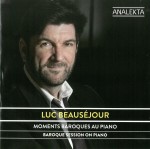 In Baroque Session on Piano (Analekta AN 2 9128) harpsichordist Luc Beauséjour takes to the piano with pieces that he argues work well on that instrument for specific reasons. Beauséjour points out that much of the harpsichord repertoire does not play well on our modern keyboard because of the piano’s inability to deliver the clarity of complex ornamentation so often required by 15th- and 16th-century repertoire. He also points out that the darker colours of the piano’s middle registers can often obscure inner contrapuntal voices. Greater resonance is yet another factor that requires pianists to change phrasing techniques when playing harpsichord repertoire.
In Baroque Session on Piano (Analekta AN 2 9128) harpsichordist Luc Beauséjour takes to the piano with pieces that he argues work well on that instrument for specific reasons. Beauséjour points out that much of the harpsichord repertoire does not play well on our modern keyboard because of the piano’s inability to deliver the clarity of complex ornamentation so often required by 15th- and 16th-century repertoire. He also points out that the darker colours of the piano’s middle registers can often obscure inner contrapuntal voices. Greater resonance is yet another factor that requires pianists to change phrasing techniques when playing harpsichord repertoire.
Selecting a program that avoids the worst of these problems, Beauséjour presents an attractive mix of frequently recorded works and others less well known. A couple of familiar Scarlatti sonatas and Rameau’s Les Indes Galantes deliver wonderfully clear and fluid runs. Bach’s Concerto in D Minor BWV974 after Marcello is an example of how the piano’s touch-based colours can make the second movement even more intensely expressive.
Other works by Louis Couperin and Georg Böhm, keep much of their harpsichord character with graceful arpeggios that Beauséjour retains more for a sense of period style than necessary technique. He includes a set of four Correnti by Frescobaldi and imbues them with a strongly rhythmic bounce and keyboard touch that suggests the crisp attack of the harpsichord’s plectra.
Baroque Session on Piano is a very fine recording commendable for its intelligence and musicality.
Review
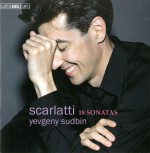 Unapologetic about the highly pianistic approach he takes, Yevgeny Sudbin admits that playing Scarlatti on the piano is in reality a transcription for a new instrument. Consequently, Scarlatti – 18 Sonatas (BIS-2138 SACD) is fully piano, with sustain pedal wherever needed, generous dynamic expression and every other technique the modern instrument can offer. Sudbin makes no effort at historical performance practice and instead claims the freedom to do whatever the music leads him to do – on the piano.
Unapologetic about the highly pianistic approach he takes, Yevgeny Sudbin admits that playing Scarlatti on the piano is in reality a transcription for a new instrument. Consequently, Scarlatti – 18 Sonatas (BIS-2138 SACD) is fully piano, with sustain pedal wherever needed, generous dynamic expression and every other technique the modern instrument can offer. Sudbin makes no effort at historical performance practice and instead claims the freedom to do whatever the music leads him to do – on the piano.
The result of all this might be a little shocking but is, ultimately, very believable because of the quality of the musical decisions underlying these controversial choices. Scarlatti remains identifiably Scarlatti, albeit with a new voice. Sudbin’s playing is undeniably gorgeous, rich in colour and texture, and everything the piano wants it to be.
As a litmus test for open mindedness on this issue compare the familiar Sonata in C Major K159 to any other performance, especially the Beauséjour described above.
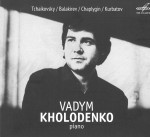 Winner of the 14th Van Cliburn International Piano Competition, Vadym Kholodenko has released a new recording with a varied program showing his remarkable versatility. In Tchaikovsky/Balakirev/Chaplygin/Kurbatov (Melodiya MEL CD 10 02365), Kholodenko opens with Balakirev’s Sonata No.2 in B-Flat Minor Op.102, a beautiful if curious work. The first movement begins with a contrapuntal idea that could have been written by Bach, and this is exactly how Kholodenko plays it. The second and third movements become increasingly Chopinesque until the Finale leaves no doubt where Balakirev’s French stylistic influences originate.
Winner of the 14th Van Cliburn International Piano Competition, Vadym Kholodenko has released a new recording with a varied program showing his remarkable versatility. In Tchaikovsky/Balakirev/Chaplygin/Kurbatov (Melodiya MEL CD 10 02365), Kholodenko opens with Balakirev’s Sonata No.2 in B-Flat Minor Op.102, a beautiful if curious work. The first movement begins with a contrapuntal idea that could have been written by Bach, and this is exactly how Kholodenko plays it. The second and third movements become increasingly Chopinesque until the Finale leaves no doubt where Balakirev’s French stylistic influences originate.
Despite this kaleidoscope of voices, Kholodenko provides a consistent and expressive approach. His playing style feels very choreographic. His keyboard presence is graceful yet powerful but not overbearing. Videos of his performances show him to be a physically restrained pianist but highly focused on expressiveness and this is, in fact, the first and most lasting impression he makes.
Tchaikovsky’s rarely heard Six Pieces on a Single Theme, Op. 21 is the only such short cycle he wrote. It uses a 15-note series embedded in the opening bars of each piece, varied only in rhythm. Kholodenko treats each section as a distinct character piece and closes the work with an impressive and energetic Scherzo.
Little Cyprian Music (2003) by Evgeny Chaplygin is a contemporary piece that compiles a series of musical impressions of a holiday on that island. It’s richly textured and technically very demanding in some passages. Kholodenko focuses on the composer’s intent in conveying the dance-like nature and Eastern flavour of Cypriot music.
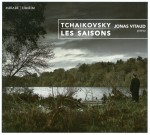 French pianist Jonas Vitaud has only a few recordings to his credit, and while he’s already in his mid-30s, his remarkable playing would suggest we should really be hearing more from him. His newest recording Tchaikovsky – Les Saisons (Mirare MIR 308) offers two starkly contrasting works.
French pianist Jonas Vitaud has only a few recordings to his credit, and while he’s already in his mid-30s, his remarkable playing would suggest we should really be hearing more from him. His newest recording Tchaikovsky – Les Saisons (Mirare MIR 308) offers two starkly contrasting works.
The Seasons Op.37a is an introspective work constructed on a calendar scheme with 12 sections. The music has some programmatic content based on activities or events associated with each month of the year. It is, more significantly, marked by a constant presence of fragility that is perhaps best known in the often quoted Barcarolle representing June. Even December – Noël concludes the cycle lightly and quietly. Maintaining this emotional posture with only a few energetic releases in sections like La Chasse is a challenge that Vitaud handles beautifully. His tenderness and fragility never convey weakness but seem perfectly poised. His playing is assured, even in the most tentative of Tchaikovsky’s moments.
By contrast, the Grand Sonata in G Major Op.37 begins with huge chordal gestures of confidence. These are echoed with even greater energy in the closing movement and played at furious speed. Still, the Grand Sonata contains a remarkable moment in the second movement Andante (about a third of the way through) where Vitaud strikes a dense chord and lets it sustain with all the dampers up off the strings. The resulting resonances grow by the moment into a rich texture not achievable by any other means. It’s a stunning device that he repeats near the end of the movement with the same result. It’s brilliant and creative.
We need more recordings by this fine musician who’s definitely worth hearing.
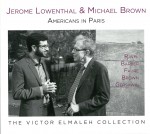 Piano four-hands offers a texture not quite achieved in any other keyboard configuration. The possibilities for density and polyphony have enticed composers since keyboards became commonplace. Pianists Jerome Lowenthal and Michael Brown have just released Americans in Paris (Concert Artists Guild Records VEC 116 concertartists.org) and recorded some favourites including the Ravel Ma mère l’Oye that includes short bits of introductory narration to setup the fairy-tale background of each segment.
Piano four-hands offers a texture not quite achieved in any other keyboard configuration. The possibilities for density and polyphony have enticed composers since keyboards became commonplace. Pianists Jerome Lowenthal and Michael Brown have just released Americans in Paris (Concert Artists Guild Records VEC 116 concertartists.org) and recorded some favourites including the Ravel Ma mère l’Oye that includes short bits of introductory narration to setup the fairy-tale background of each segment.
Samuel Barber’s Souvenirs Op.28 is a compilation of dances set in New York’s Plaza Hotel about 1914 and evokes the music Barber would have heard as a boy when taken there by his mother for tea. Lowenthal and Brown make an outstanding piano duo and deliver these dances, many of which have ample humour injected into them, with impeccable precision.
Plenty of piano students have played the four-hands Dolly Suite Op.56 by Gabriel Fauré. This performance is well-paced. Messieu Aoul and Le pas espagnol are especially admirable for the coordinated energy and execution they require.
The highlight of the CD is a four-hands arrangement of George Gershwin’s An American in Paris. It’s an autobiographical work recounting Gershwin’s own time there in the mid-1920s. It features some obvious references early in the work to the set of authentic Parisian taxi horns Gershwin had purchased during his trip. Lowenthal and Brown seem most at home in this piece, really feeling the deep melancholy of the blues section, as well as the jazzy syncopations that drive so much of the music.
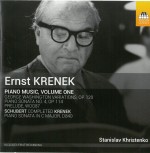 Ernst Krenek was one of the 20th century’s most stylistically complete composers whose vocabulary gave him creative access to both historical and contemporary expression. On Ernst Krenek – Piano Music, Volume One (Toccata Classics TOCC 0298), Ukrainian-born Stanislav Khristenko performs a well-balanced program of Krenek’s compositions.
Ernst Krenek was one of the 20th century’s most stylistically complete composers whose vocabulary gave him creative access to both historical and contemporary expression. On Ernst Krenek – Piano Music, Volume One (Toccata Classics TOCC 0298), Ukrainian-born Stanislav Khristenko performs a well-balanced program of Krenek’s compositions.
The Piano Sonata No.4 Op.114 (1948) is a work in which Khristenko demonstrates Krenek’s ability to move seamlessly between ideas that are tonally centred and others that aren’t. Khristenko not only captures the neo-romantic essence of Krenek’s language, but also the unsettling elements of the composer’s early life that express themselves in the edgy phrasing he uses to evoke the changed world emerging from the two world wars.
Khristenko’s choice of the George Washington Variations, Op.120 (1950) is especially entertaining for its use of all of Krenek’s favourite devices. Deployed as they are, they move an opening 19th-century military march through a metamorphosis of clever changes in which Khristenko never lets go of the initial musical idea.
Krenek held a lifelong devotion to the music of Franz Schubert. He spent years coming to understand the genius of Schubert’s music, its design and balance, especially as present in his lieder. Krenek’s decision to complete Schubert’s Piano Sonata in C Major D840 is based solely on the existence of sufficient thematic material in the final two movements to make credible development possible. Naturally, it’s difficult to listen to this Schubert without also listening for some Krenek.
Khristenko is also currently working on recording the complete works of Krenek as well as a recording of Soler sonatas.
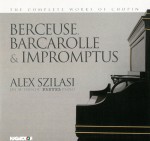 It can be understandably difficult to get terribly excited about a recording of an upright piano, especially if it’s old, really old, say 1834. So why would Alex Szilasi record Chopin Berceuse, Barcarolle & Impromptus (Hungaroton HCD32473) on an old Pleyel upright? Evidently this one is special – Chopin played it. Pleyel Company archives show that Chopin played it at the factory in Paris and selected it for the Russian ambassador. He liked this particular model so much that he ordered one for himself. Both instruments were delivered to adjacent apartments at the ambassador’s residence where Chopin was a frequent guest. While Chopin’s piano was eventually lost, the other instrument has survived fully authenticated. This is its recording debut.
It can be understandably difficult to get terribly excited about a recording of an upright piano, especially if it’s old, really old, say 1834. So why would Alex Szilasi record Chopin Berceuse, Barcarolle & Impromptus (Hungaroton HCD32473) on an old Pleyel upright? Evidently this one is special – Chopin played it. Pleyel Company archives show that Chopin played it at the factory in Paris and selected it for the Russian ambassador. He liked this particular model so much that he ordered one for himself. Both instruments were delivered to adjacent apartments at the ambassador’s residence where Chopin was a frequent guest. While Chopin’s piano was eventually lost, the other instrument has survived fully authenticated. This is its recording debut.
Chopin favoured the Pleyel piano for its soft tone. It was double-strung in its middle and upper registers and therefore softer than later triple-strung instruments. It responds to the gentlest touch to produce nearly inaudible pianissimos. Aggressive or heavy touch tends to cause distortion on these instruments, so Chopin would have favoured them for very specific repertoire, and certainly nothing terribly bombastic, hence this CD’s program of more tender compositions.
Szilasi creates some amazing effects with the instrument. The rapid chromatic runs in the right hand through the upper octaves of the keyboard sound extremely fragile like a web of silk threads, yet they remain clear although very soft. This is best heard in the Impromptu in F-Sharp Major Op.36. The familiar Fantasie-Impromptu in C-Sharp Minor Op.72 is also a dramatic contrast to the more muscular performances commonly heard on modern pianos.
Alex Szilasi has created a thought-provoking recording that gives us a glimpse of how Chopin would have heard and played his own music 180 years ago.



